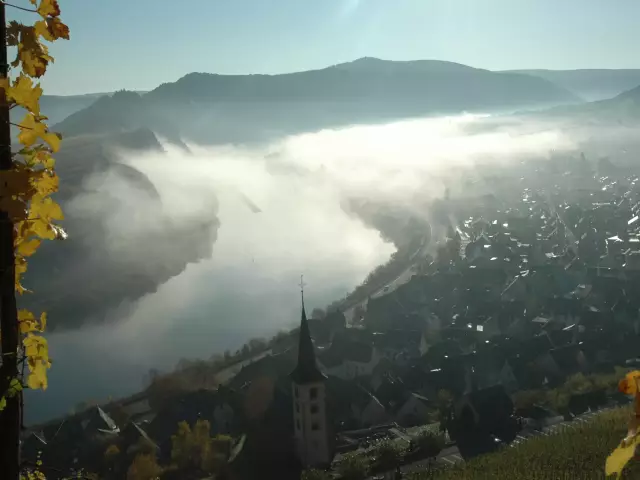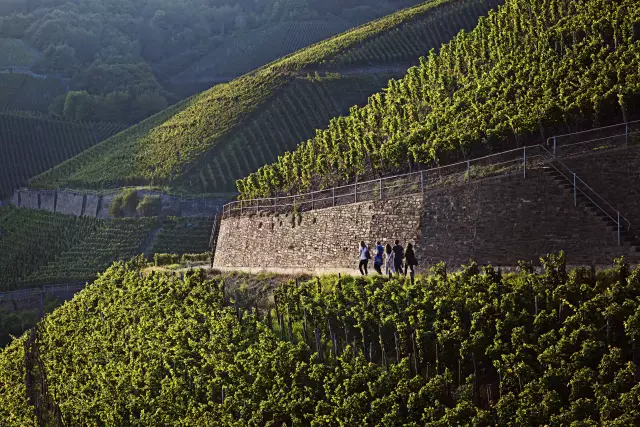Mosel

The wine-growing region along the Moselle, Saar and Ruwer rivers is considered Germany's oldest wine region. The Romans brought viticulture to the Moselle on a grand scale.
Facts
-
8.536 ha
Vineyard area
-
524
Einzellagen
-
> 30°
Slope
The Mosel River is the sinuous spine of the Mosel region, changing direction so often as it flows northeast toward the Rhine that it meanders nearly 250 km, to cover about half that distance as the crow flies. Together with its two small tributaries, the Saar and the Ruwer, the Mosel composes one wine growing region, considered the oldest in Germany. Countless finds, including several wine presses from Roman times, testify to the long history of viticulture here and the large scale of its introduction by the Romans.
Along the Mosel between Perl and Koblenz, on the Saar between Serrig and Konz and on the Ruwer between Riveris and the Trier district of Ruwer, around 5,000 winegrowers cultivate a total of 8,536 hectares (2023) across 125 wine towns. This is often under extremely difficult conditions as nowhere in the world are there more steep vineyards than in the fifth largest wine-growing region of Germany. Today half of the vineyards are on steep and terraced sites with a slope of over 30 degrees, some planted at an astounding 70-degree gradient. On these precipitous inclines, nearly all grapes have to be picked by hand. That includes tying each vine to its own eight-foot wooden stake, and carrying up the slate soil that has washed down with the winter rains. Very labour-intensive and a true sign of dedication to cultivating unique wines.
The region is divided into six areas. The area of Burg Cochem on the lower Mosel is often referred to today as the terraced Mosel, as this is often the only possible way to grow vines on the radically steep slopes. The steepest vineyard in Europe, the Bremmer Calmont is here. The Bernkastel area is known as the Middle Mosel. It is the heart of the growing region, with well-known wine-growing communities and famous vineyard sites. The Upper Mosel begins south of Trier. The Mosel Gate area, part of the Upper Mosel, belongs to Saarland. Viticulture is also practiced in the Saar area and the Ruwertal is the smallest part of the region.
The Mosel winegrowers rightly see themselves as Riesling specialists, with 5,354 hectares planted. The late-maturing, noble white variety thrives in the conditions here. The protected valley location makes the region one of the warmest climates in Germany. The steep slate slopes above the rivers store the sun's heat during the day and release it again at night. The roots of the vines penetrate deep into the ground to seek water and minerals. In this way, the winemakers can produce uniquely fine, fruity wines that have an enormous depth of flavor and a relatively low alcohol content - ideal for easy enjoyment.
Also world-renowned are the noble-sweet wines of this region, with record prices attained every year at auctions, as well as the many excellent, dry and semi-dry wines that win national and international competitions.
Slate and Riesling dominate the vineyards, with other varietals grown in smaller quantities. Rivaner (Müller-Thurgau) is the second most important grape variety and Elbling, an old grape variety on the Upper Mosel, may have been cultivated here for 2,000 years. Fresh, fruity and uncomplicated dry and sparkling wines are made from it. Pinot Blanc and Gris, as well as Auxerrois and Chardonnay, are increasingly being planted, which produce excellent wines on the limestone soils. Red wines, especially Pinot Noir and Dornfelder, have also been available on the Mosel, Saar and Ruwer since the late 1980s.
The region is a highly attractive travel destination. You can get to know it better with a qualified Wine Guide who will take you on a special tour, showing the most beautiful places on the three rivers and creating a unique wine experience.
MOSEL
Overview Mosel
Geographical location: The Mosel Valley, a gorge the river carved between the Hunsrück and Eifel hills, and the valleys of its tributaries, the Saar and Ruwer rivers.
Major town(s): Koblenz, Cochem, Zell, Bernkastel, Piesport, Trier
Climate: Optimal warmth and precipitation in the steep sites and valleys
Soil types: Clayish slate and greywacke in the lower Mosel Valley (northern section); Devonian slate in the steep sites and sandy, gravelly soil in the flatlands of the middle Mosel Valley; primarily shell-limestone (chalky soils) in the upper Mosel Valley (southern section, parallel with the border of Luxembourg)
Vineyard area 2022: 8,536 ha · 6 districts · 19 collective vineyard sites · 500+ individual sites
Grape varieties 2022 [white 91% · red 9%]: Riesling (62.4%), Müller-Thurgau (9%), Elbling (5%), Pinot Blanc (4.3%) and Pinot Noir (5%).
Marketing: About one fifth of the region's grape harvest is handled by the regional cooperative cellars in Bernkastel-Kues. Overall, the producers of bottled wine are cooperatives, estates and commercial wineries. The latter also bottle and commercialize some wines from other German wine-growing regions (e.g. the Pfalz and Rheinhessen) as well as less expensive, imported wines. Much of the production is exported. Nevertheless, selling wines to private end users is important for smaller wineries, who benefit from the region's tourism.
Signposted routes through wine country: Mosel Weinstraße (driving) · Moselhöhenweg (hiking) · Römische Weinstraße (driving) from Leiwen to Schweich · Elbling Route (driving) from Konz to Perl, parallel to the Luxembourg border.
VIDEO: Romans, Riesling, steep slopes
Varietals

Quotes
Highlights of wine culture in Mosel
-
Highlight Wine Estate Vereinigte Hospitien Wine Estate of the Vereinigte Hospitien - The Oldest Wine Cellar in Germany
Learn more -
Highlight Lubentiushof Winery Weingut Lubentiushof - A Modern Wine Workshop in an Old Wine Village
Learn more
Winesights
Wine hike In the Footsteps of the Romans
This magnificent hiking route is certainly not an easy one. After all, it is important to master no less than 600 vertical meters over a distance of a good 20 kilometers.

Contact
-
Mosel-Wein e.V.
54295 Trier-Kürenz Güterstraße 72 Rheinland-Pfalz Germany










